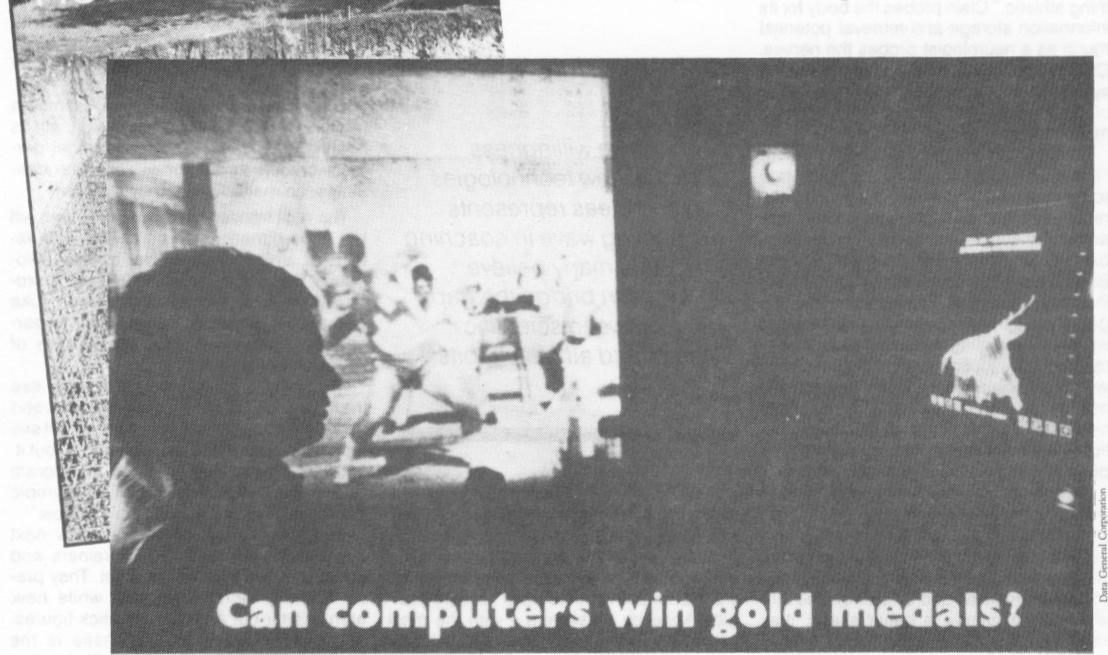| Index | Next |
![]()
Computer technology allows us to analyze athletic performance in more detail than ever before. We can learn why some athletes win and how others might.
Gideon Ariel uses an electronic pen to trace a film frame of a shot putter; a computer simultaneously displays the image
Dr Gideon Ariel
is director of research at Computerized Biomedical Analysis Inc, Amherst, Massachusetts
All top athletes are highly trained: but why are some so obviously better than others? In the past, performance depended largely on raw talent; and was improved by training, new subtleties of tech
nique, and better equipment. But now the computer is giving a new edge of exactitude to training, technique and selection of athletes. It can help us to relate an athlete's performance precisely to what he does; and also to find out why some people are innately better equipped for particular events than others.
To throw, run or jump, the human body must obey the same physical laws as all other earthly objects; the laws of motion govern its performance. It is impossible to throw the shot 70 feet (21-3 metres) if the thrower cannot achieve the right shot velocity and angle of release. These values do not vary from athlete to athlete; for each particular shot velocity there is one optimum angle. If a person wants to leap 29 feet (9 m)-as only one man in history, Bob Beamon. has ever done-he must produce forces on the ground that will propel his body with a specific force of reaction at a particular angle. This force is unique: it is impossible to cover the same distance with less force, as gravitational forces act uniformly, whoever is jumping.
Biomechanical research relies primarily on data from high speed tine films and measurements of body motion and forces. The data comprise kinematic data, including a description of the motion in terms of the displacement, velocities and acceleration of parts of the body; and kinetic data consisting of the measurement of forces, moments of force and analysis of the body's centre of gravity. Computer technology helps us to combine the results of high
speed photography with the anatomical data so that we can find the best use of the human body, and reduces long tedious hours of tracing and hand calculations to a matter of minutes.
In the technique we have developed at Computerized Biomechanical Analysis Incorporated we photograph the athlete in action and project the developed film on a "digitiser screen". We then touch the image's joints with a stylus which transmits the X-Y coordinates of each point touched to a computer memory. As each frame of the film is digitised the computer writes the points on a graphic display and connects them by lines to form "stick figures". In this way an athlete's complete movement can be recreated as a series of stick figures on the screen and we can follow the movement of different parts of the body (see Boxes). Repeating these procedures for several camera views produces 3-dimensional analyses of the action; at least two cameras are needed to give two lines of sight to define the position of any point in space.
To calculate the forces, and moment of force, we need to know the mass of each body segment, or limb, as well as its centre of gravity; a publication by the Aerospace Medical Research Laboratory supplies the necessary values. A program we have developed computes the lengths, angular displacements, velocities and accelerations for each body segment. Using the graphics display we then observe the effects of adjusting the values of these variables until they best reproduce the curve followed by a particular point of the body during the movement filmed. That is, the displacement of each body segment from frame to frame is adjusted independently to obtain the best smooth "fit" to the raw data; this is necessary to overcome human errors inherent in the digitising process.
NEW SCIENTIST July 1980


![]()
| Index | Next |